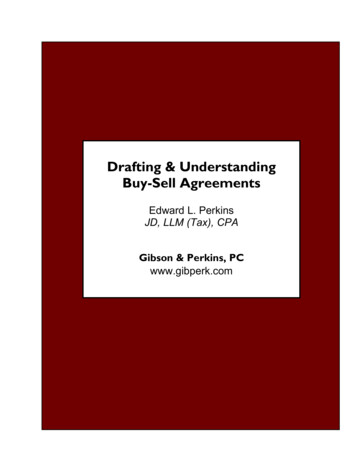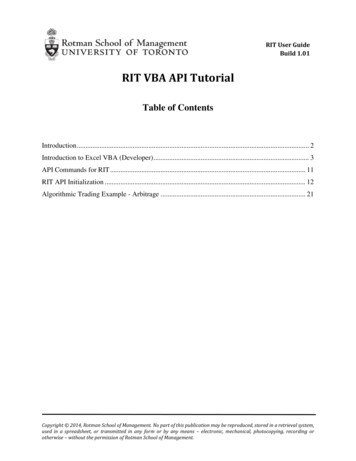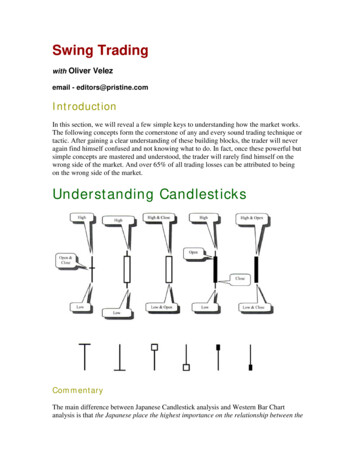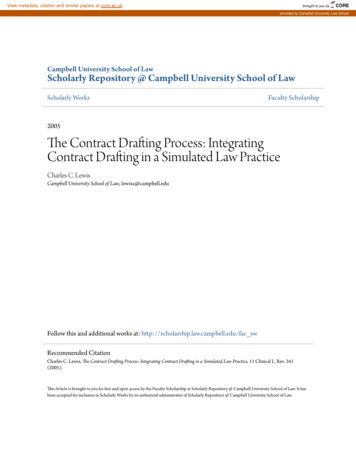
Transcription
Drafting & UnderstandingBuy-Sell AgreementsEdward L. PerkinsJD, LLM (Tax), CPAGibson & Perkins, PCwww.gibperk.com
DRAFTING AND UNDERSTANDINGBUY-SELL AGREEMENTSIntroductionThis program will provide a comprehensive overview of legal and tax issues involved in drafting andunderstanding Buy-Sell Agreements. Among the topics examined in this program are: The Form of the Agreement Determining the Restrictions on Transfer Triggering Events The Purchase Rights The Terms of the Purchase Determination of the Purchase Price Setting the Purchase Terms for Each Triggering Event Tax Consequences Additional Issues to AddressCourse Learning ObjectivesAfter course completion you will be able to: Distinguish the purposes for which Buy-Sell Agreements are used. Recognize the issues addressed by Buy-Sell Agreements. Distinguish between the characteristics of the various forms of Buy-Sell Agreements. Identify the nature of the restrictions generally provided in a Buy-Sell Agreement. Identify the events which generally trigger obligations under a Buy-Sell Agreement. Recognize the purchase obligations generally provided in a Buy-Sell Agreement. Identify the alternative methods of determining the purchase price in Buy-Sell Agreements. Identify the manner in which price is determined under each of the alternative methods discussed. Recognize the pros and cons of each of the alternative valuation methods. Identify the various terms of purchase that the Buy-Sell Agreement should address. Identify the appropriate purchase rights, purchase price, and terms of the purchase which should beprovided in regard to the various triggering events. Identify the tax consequences of the various forms of Buy-Sell Agreements as they relate to: (i) theparty funding payment of the purchase price; (ii) the selling owner; (iii) the remaining owners, and (iv)the purchasing party. Identify issues that should be addressed in a Buy-Sell Agreement in addition to those alreadydiscussed.
Contributors Prepared and Presented by Edward L. Perkins, JD, LLM (Tax), CPA Reviewer - Stephen Loester, JD, LLM (Tax)Refund PolicyIt is the policy of YourOnlineProfessor.net to satisfy participants and purchasers in a reasonable manner.Therefore, refunds to dissatisfied participants will be given in order to maintain good will. However, thereason for a participant's dissatisfaction and any resulting refund must be clearly indicated. Each refundrequest will be reviewed by a majority of the members of YourOnlineProfessor.net. A refund is always givenif a course does not qualify for CPE credit in the state in which the purchaser seeks to apply it for credit.Program Cancellation PolicyIt is the policy of YourOnlineProfessor.net to refund in full any fees paid in the event that a scheduledprogram is cancelled or rescheduled.Complaint Resolution PolicyAll evaluations are reviewed by Edward Perkins. Grievance complaints are directed to Mr. Perkins at (610)565-1708 ext. 2 or via email to yop@youronlineprofessor.net. It is the policy of YourOnlineProfessor.net torespond to every grievance complaint. This response shall include when appropriate: reviewing thegrievance complaint in conjunction with other participant evaluations and discussion of the grievancecomplaint with the course instructor or other employees.Course Update PolicyYOP’s policy is to have each webinar program reviewed prior to initial presentation and updated in the caseof the re-presentation of a program by a qualified person other than the person who developed the programto assure that the program is technically accurate and current and addresses the stated learning objectives.Since all of our programs have been in the field of study of taxes, a tax attorney holding an LLM in Taxationhas been the reviewer in each case. Any programs outside the field of study of taxes will be reviewedconsistent with this policy by an expert in that field of study.Review QuestionsThroughout the course you will find Review Questions to help you test your knowledge and comments thatare vital to understanding a particular strategy or idea. Answers to the Review Questions with feedback onboth correct and incorrect responses are provided following each “Quizzer.”Final ExamThis course is divided into 7 sections. Take your time and review all course sections. When you feelconfident that you thoroughly understand the material, turn to the Final Exam on page 50 and complete it.Once completed, submit the Final Exam using the instructions found on page 52 to receive CPE credit.ii
DRAFTING AND UNDERSTANDINGBUY-SELL AGREEMENTSContentsUNIT ONE – Introduction 1I.Overview . 1II.Uses of the Buy-Sell Agreement .1III.Issues to be Addressed .1UNIT TWO – The Form of the Agreement 5I.Overview .5II.The Cross Purchase Agreement .5III.Redemption Agreement .5IV.Hybrid Agreement .5V.Alternative Documentation 6UNIT THREE – Determining the Restrictions on Transfer, the Triggering Events and the PurchaseRights .9I.Introduction .9II.The Nature of the Restrictions .9III.The Triggering Events 11IV.The Purchase Rights .15UNIT FOUR – Determination of the Purchase Price .19I.Overview .19II.Agreed Upon Price .19III.Price Determined by Appraisal .20IV.Price Determined by Formula 22UNIT FIVE – Terms of the Purchase .28I.Overview .28II.Closing .28III.Payment of the Purchase Price 28iii
UNIT SIX – Setting the Purchase Terms for Each Triggering Event .30I.Introduction .30II.Death of an Owner .30III.Voluntary Transfers and Involuntary Transfers .31IV.Disability 32V.Termination of Employment .32UNIT SEVEN – Tax Consequences 36I.Overview 36II.Income Tax Consequences 36III.Estate Tax Consequences. 39UNIT EIGHT – Additional Issues to Address .43I.Overview. . .43II.Consent to Joint Representation . .43III.Disposition of Insurance Policies. . .43IV.Resignation as Officers and Directors. . .43V.Covenant Not to Compete and Non-Interference . .44VI.Preserving the S Election . .44VII.Provision for Distribution – S Corporations .46VIII.Take Along and Tag Along Provisions . 46IX.Spouse’s Signature . 47X.Adoption by New Owner .48XI.Legend. .48CPE QUIZZER50Glossary of Terms .53Index .55Appendix 57iv
UNIT ONE – IntroductionLearning ObjectivesAfter completing this Unit, you will be able to:›Distinguish the purposes for which Buy Sell Agreements are used.›I.Recognize the issues addressed by Buy-Sell Agreements.Overview.A Buy-Sell Agreement is a contractual agreement among the owners of a business (i.e., the shareholdersof a corporation, the partners of a partnership, or the members of a limited liability company) which restrictsthe right to transfer the ownership interests and establishes certain purchase and sale rights andobligations upon the occurrence of certain events. The agreement will generally provide that upon theoccurrence of the triggering events, such as the death of an owner, the remaining owners will either havean option or an obligation to purchase the ownership interest of the affected owner.II.Uses of the Buy-Sell Agreement.A Buy-Sell Agreement may serve to achieve one or more of the following objectives:1.Restriction of Transfer - By restricting the transfer of an ownership interest except asprovided within the terms of the agreement, a Buy-Sell Agreement can insure that owners control andrestrict who is part of the ownership group.2.Provides Liquidity - If the agreement provides a purchase obligation in the event of thedeath of an owner and that obligation is funded with life insurance, the agreement can be used to convertthe deceased owner’s equity interests into cash.3.Fixes Value - By fixing the price which applies in the event of a purchase under the termsof the agreement, the estate tax value of the equity can be fixed in the estate of a deceased owner.III.Issues to be Addressed.The agreement should address the following issues:A.The Form of the Agreement.The Buy-Sell Agreement will generally be formed in one of the following ways: (1) a “CrossPurchase Agreement”; (2) a “Redemption Agreement”; or (3) a “Hybrid Agreement.” No matter what theform of the agreement, the objectives of the agreement are the same as discussed in section II, above. Thedifferences lie in how the purchase options and obligations are allocated between the entity and theowners. 1Example: A and B are the shareholders of XYZ, Inc. Each owns 50% of the issued andoutstanding stock of the corporation. A and B enter into an agreement which provides that1The alternative forms of the agreement will be discussed in detail in Unit Two.1
neither shareholder may sell or otherwise transfer his or her stock without first offering it tothe other shareholder at a price and terms set by the agreement. In addition the agreementprovides that upon the death of either shareholder the corporation will redeem the stock ofthe deceased owner for the fair value of the stock. The corporation purchases lifeinsurance on both A and B in order to fund this obligation.B.The Nature of the Restrictions on Transfer.One primary purpose of a Buy-Sell Agreement is to insure that before an existing owner cantransfer his or her stock, the other owners will have the opportunity to buy that interest at a predeterminedprice and terms. In order to make sure that this objective is realized, the agreement should provide that anytransfer not made within the terms of the agreement is null and void.C.Defining the Triggering Events and the Purchase Rights.The agreement, of course, should define the precise events that will trigger the purchase rights.Generally, these would include the death or disability of an owner, the termination of an owner’semployment by the entity, or the attempt to voluntarily or involuntarily transfer the ownership interest of anowner. Once the triggering event has occurred, the agreement should also provide whether the otherowners, or in certain cases the entity, have an option or obligation to purchase the ownership interest of theaffected owner.2D.Determination of the Purchase Price.The agreement should provide either the price or a method for determining the price of theownership interest to be purchased.3F.Payment Terms and Funding Mechanisms.Finally, the agreement should set the terms of the purchase, i.e. when the closing will take place,and how the purchase price will be paid, whether lump sum or in installments. In addition, the agreementshould also address the source of the payment. For purchases triggered by the death of the owner, lifeinsurance is often purchased in order to fund the buyout. 42This topic will be discussed in Unit Three.The various options available in determining price will be discussed in Unit Four.4 Terms of the purchase are discussed in Unit Five.32
Unit One QuizzerWhich of the following is an issue not generally addressed by a Buy-Sell Agreement?A.Providing restrictions on the right to transfer an equity interest in a business entity.B.Defining the event which triggers the purchase rights of the entity owners.C.Determining the purchase price of the interest sold and purchased under the terms of theAgreement.D.Determining the number of authorized shares of stock of a Corporation.3
AnswersA.Providing restrictions on the right to transfer an equity interest in a business entity.A is Incorrect - One primary purpose of a Buy-Sell Agreement is to insure that before an existing owner cantransfer his or her stock, the other owners will have the opportunity to buy that interest at a predeterminedprice and terms. In order to make sure that this objective is realized, the agreement should provide that anytransfer not made within the terms of the agreement is null and void.B.Defining the event which triggers the purchase rights of the entity owners.B is Incorrect - The agreement, of course, should define the precise events that will trigger the purchaserights. Generally, these would include the death or disability of an owner, the termination of an owner’semployment by the entity, or the attempt to voluntarily or involuntarily transfer the ownership interest of anowner. Once the triggering event has occurred, the agreement should also provide whether the otherowners, or in certain cases the entity, have an option or obligation to purchase the ownership interest of theaffected owner.C.Determining the purchase price of the interest sold and purchased under the terms of theAgreement.C is Incorrect - The agreement should provide either the price or a method for determining the price of theownership interest to be purchased.D.Determining the number of authorized shares of stock of a Corporation.D is correct – The number of authorized shares of stock of a corporation is generally provided in theArticles of Incorporation.4
UNIT TWO – The Form of the AgreementLearning Objectives›I.After completing this Unit, you will be able to:Distinguish between the characteristics of the various forms of Buy-Sell Agreements.Overview.Before addressing other issues, we should first discuss the various forms Buy-Sell Agreementsmight take. The Buy-Sell Agreement will generally be formed in one of the following ways: (1) a “CrossPurchase Agreement;” (2) a “Redemption Agreement;” or (3) a “Hybrid Agreement.” No matter what formof agreement is used, the objectives of the agreement are those previously discussed. The differencegenerally lies in how the purchase options and obligations are allocated between the entity and the owners.II.The Cross Purchase Agreement.A “Cross Purchase Agreement” is an agreement solely among the owners of the entity, i.e. theshareholders, partners, or members. The entity itself is not directly involved in the purchase rights orobligations. The funding of the obligation under this type of agreement must occur at the owner level.Example: A and B are the sole shareholders of XYZ, Inc. They entered into a Buy-SellAgreement. Under the terms of the agreement, A and B agree that neither will transfer hisor her stock in XYZ without first offering to the other shareholder. In the event either ofthem dies, the survivor has agreed to purchase the deceased shareholder’s stock at anagreed upon price.III.Redemption Agreement.A “Redemption Agreement” is similar to a cross purchase agreement with the difference being thatthe purchase obligation falls to the entity rather than the owners. Under a stock redemption plan, thecorporation must have sufficient assets to redeem the shareholder's stock when required under the stockpurchase agreement. This may be accomplished through the retention by the corporation of liquid assets orby acquiring life insurance on the lives of the various owners.Example: A and B are the sole shareholders of XYZ, Inc. They entered into a Buy SellAgreement. In the event either A or B dies, the Corporation has the obligation to purchasethe deceased shareholder’s stock.IV.Hybrid Agreement.Under a “Hybrid Agreement,” the purchase rights and obligations are shared by the entity and theowners. Generally, the entity is given the first option to purchase the equity interests and then, to the extentthe entity does not choose to exercise that option, the remaining owners would have the option orobligation to purchase the interests. In some cases the order could be reversed, giving the remainingowners the first option, and then the entity the subsequent option or obligation. The Hybrid Agreementgives the remaining owners the choice to use either entity or personal resources to effectuate thetransaction.5
Example: A and B are the sole shareholders of XYZ, Inc. They entered into a Buy SellAgreement. In the event either A or B dies, the Corporation has the first option to purchasethe deceased shareholder’s stock at an agreed upon price; if the corporation does notexercise its option, the surviving shareholder has the obligation to purchase the stock ofthe deceased shareholder.V.Alternative Documentation.In the case of corporations, the Buy-Sell provisions may alternatively be provided in thecorporation’s Bylaws or in the Articles of Incorporation. In the case of partnerships and limited liabilitycompanies, the applicable provisions may also be contained in the partnership agreement or operatingagreement of the limited liability company.6
Unit Two QuizzerWhich of the following best describes a characteristic of a Cross Purchase Agreement?A.The agreement is solely among the owners of the entity, i.e. the shareholders, partners, ormembers. The entity itself is not directly involved in the purchase rights or obligations.B.The purchase obligations fall to the entity rather than the owners.C.The applicable provisions may be contained in the By-Laws of the corporation, the partnershipagreement, or operating agreement of the limited liability company.D.The purchase rights and obligations are shared by the entity and the owners.7
AnswersWhich of the following best describes a characteristic of a Cross Purchase Agreement?A.The agreement is solely among the owners of the entity, i.e. the shareholders, partners, ormembers. The entity itself is not directly involved in the purchase rights or obligations.A is Correct – This is a characteristic of a Cross Purchase Agreement.B.The purchase obligations fall to the entity rather than the owners.B is Incorrect - This is a characteristic of a Redemption Agreement.C.The applicable provisions may be contained in the Bylaws of the corporation, the partnershipagreement or operating agreement of the limited liability company.C is Incorrect – Buy-Sell provisions are not always provided in a separate agreement. These are examplesof alternatives to providing Buy-Sell provisions in an agreement.D.The purchase rights and obligations are shared by the entity and the owners.D is Incorrect - This is a characteristic of a Hybrid Agreement.8
UNIT THREE – Determining the Restrictions on Transfer,the Triggering Events, and the Purchase RightsLearning ObjectivesAfter completing this Unit you will be able to:››Identify the events which generally trigger obligations under a Buy-Sell Agreement.›I.Identify the nature of the restrictions generally provided in a Buy-Sell Agreement.Recognize the purchase obligations generally provided in a Buy-Sell Agreement.Introduction.This Unit will discuss the general nature of the restrictions that the Agreement should place on thetransfer of the ownership interests, the events that trigger purchase options or obligations, and the nature ofthose purchase options and obligations.II.The Nature of the Restrictions.A. General Nature of RestrictionsBy restricting the transfer of an ownership interest outside of the ownership group, a Buy-SellAgreement can help the owners control and restrict who is part of the ownership group. The Agreementshould provide a general restriction on the transferability of the ownership interests. Here is some standardlanguage:“The Shareholders agree that they will not except asprovided in this Agreement, sell, exchange, give,bequeath, assign, mortgage, pledge, alienate,hypothecate or otherwise transfer or encumber, in anymanner whatsoever (any such disposition beinghereinafter referred to as a ‘Transfer’), the StockInterests in the Corporation presently held, orhereafter acquired, by them, except in accordance withthe terms of this Agreement.”The Agreement should also provide that any transfer made or attempted contrary to the terms ofthe Agreement is null and void. Here is some standard language:“Except as specifically provided herein, any Transferby a Shareholder of all or any portion of the StockInterests held by him, except in the manner specifiedin this Agreement, shall be null and void, and theCorporation shall not recognize or give effect to suchTransfer on its books and records, or recognize theperson or persons to whom such Transfer has been madeas the legal or beneficial holder thereof.9
In the event of an attempted Transfer by a Shareholderof all or any portion of the Stock Interests held byhim in violation of this Agreement, the Corporationshall have the right to purchase all (but not lessthan all) of the Stock Interests in the Corporationheld by such Shareholder at a price of One Dollar( 1.00) per share.”B. Permitted TransfereesIn many Agreements certain transfers are permitted as long as they are made to so-called“permitted transferees.” Here is some sample language:“4.9.4As provided above, the following exempttransfers may be made:4.9.4.1Transfers to the spouse or a linealancestor or descendent of such Shareholder (whether byadoption, blood or marriage), or4.9.4.2Transfers to a trust for the exclusivebenefit of such Shareholder or a spouse or linealancestor or descendent of such Shareholder (whether byadoption, blood, or marriage); and, provided further,that a change in the beneficial interests of suchtrust to include anyone other than the spouse or alineal ancestor or descendent of such Shareholder(whether by adoption, blood, or marriage) shall beconsidered a Transfer of the Shares held by suchtrust, subject to the same restrictions, rights, andobligations otherwise provided hereunder in regard tosuch Shares.4.9.4.3Transfers to a corporation,partnership, or limited liability company, which iswholly owned by such Shareholder or a spouse or linealancestor or descendent of such Shareholder (whether byadoption, blood, or marriage); and, provided further,that the Transfer of an ownership interest of suchcorporation, partnership, or limited liability companyto anyone other than the spouse or a lineal ancestoror descendent of such Shareholder (whether byadoption, blood, or marriage) shall be considered aTransfer of Shares held by such corporation,partnership, or limited liability company, subject to10
the same restrictions, rights, and obligationsotherwise provided hereunder in regard to such Shares.4.9.5The term “valid testamentary transfer” shallbe defined as any testamentary transfer which legallytransfers title to a decedent’s property by reason ofhis/her death, including, but not limited to,transfers by will, trust, intestacy, designation ofbeneficiary, and right of survivorship.”III.The Triggering Events.A.Overview.The occurrence of the events that trigger the purchase options or obligations must be defined inthe Agreement.B.Death of an Owner.In the event of the death of an owner, the Buy-Sell Agreement generally will provide that theownership interest of the deceased owner must be sold and purchased. Here is some typical language:“(1) Upon the death of a Member (the ‘DeceasedMember’), the Deceased Member’s personalrepresentative shall sell and transfer such DeceasedMember’s entire Membership Interest owned by suchMember (the ‘Offered Interest’) according to theprocedure provided in this subparagraph.”C.Voluntary Transfers and Involuntary Transfers.The Agreement should provide that an attempted “transfer” of the ownership interest triggers apurchase right in the other owners and/or the entity. The term “transfer” should be given a broad definitionsuch as the following:“The Members agree that they will not, except asprovided in this Agreement, sell, exchange, give,bequeath, assign, mortgage, pledge, alienate,hypothecate or otherwise in any manner whatsoevertransfer or encumber (any such disposition beinghereinafter referred to as a “transfer”) theMembership Interests of the Company presently held, orhereafter acquired, by them.”1.A “voluntary transfer” is an attempted or proposed voluntary lifetime transfer of theownership interest by an owner—generally by sale or gift. The following is a form definition of such:11
“The term ‘Voluntary Lifetime Transfer’ shall bedefined as any Transfer made during a Member’slifetime that is not an Involuntary LifetimeTransfer.”Sometimes transfers to so-called “permitted transferees” under the agreement are made exemptfrom the restriction. “Permitted transferees” may be defined to include spouses and descendants, andtrusts for their benefit.2.An “involuntary transfer” is generally any transfer made on account of a court orderor otherwise by operation of law, including any transfer incident to any divorce or marital propertysettlement, or an owner filing a voluntary petition under any federal or state bankruptcy law.The following definition can be used:“The term ‘Involuntary Lifetime Transfer’ shall be definedas any Transfer made on account of a court order orotherwise by operation of law, including any Transferincident to any divorce or marital property settlement orany Transfer pursuant to applicable community property,quasi-community property or similar state law, and alsoincluding a Member filing a voluntary petition under anyfederal or state bankruptcy, insolvency or related law or apetition for the appointment of a receiver, or making anassignment for the benefit of creditors, or being subjectedinvoluntarily to such a petition or assignment or to anattachment or other legal or equitable interest withrespect to his Interest in the Company and such involuntarypetition, assignment, or attachment is not dischargedwithin thirty (30) days after its effective date.”D.Disability.Normally a buyout based on “disability” is only appropriate if the owner is employed by the entityand the individual service contributions of the owner are vital to the business of the entity. Defining when acondition of “disability” occurs to the degree which would result in a buyout of an owner’s interest is adetermination to be made by each ownership group.As a guideline, there are generally three stages of disability. First, a period during which the owneris not able to work, but it is foreseeable that he or she will return to work in the short term. During thisperiod, wages are usually paid in full and ownership is not affected. In the second stage, the condition hasbeen prolonged to the point that full wages are no longer considered appropriate. During this period,disability income insurance could make up some of the income short fall for the disabled owner. In thissecond stage, the ownership interest is again left unaffected. Finally, the third level of disability occurs atthe point the disability is considered permanent, at which time the buyout is triggered. Again, defining this12
point is difficult. If disability income or buyout insurance is in place, reference to the definition in thosepolicies may be appropriate. Generally, the determination of the condition of “disability” should not be madeby the board of directors or managing partner or member. A better alternative is to have the conditiondetermined or confirmed by one or more physicians.Here is a sample provision based on the definition in the disability insurance policy:"Disability" or "total and permanent disability" forpurposes of this agreement shall be considered thatdisability of an insured stockholder which isdescribed and determined by the insurer as "total andpermanent disability" in the insurance policies onsuch insured stockholder listed in Article 4 belowand/or Schedule "B" attached hereto.”Here is a second sample provision:“The term ‘Total Disability’ shall be defined as aMember being unable, due to injuries or illness, toperform the substantial and material duties of hisemployment by the Company or the Corporation, as thecase may be, for twelve consecutive months, and unlesssuch care is of no further benefit, such Member isalso receiving care by a physician which isappropriate for the condition causing the disability.”E.Termination of Employment.Another triggering event may be the termination of employment of an owner by the entity forreasons other than death or disability. This may occur because an owner/employee retires voluntarily at acertain age, is involuntarily terminated for cause, or simply quits. Whether termination of employment isincluded as a triggering event in an agreement is an interesting question. The answer depends on severalfactors; including, the basis for the termination and the nature of the owner’s employment by the entity. Ifthe termination is voluntary, then whether this is a reason to trigger a buyout depends on the owner’srelationship to the company. If the owner is an integral contributor to the day-to-day operation of thebusiness, then termination of employment may be considered a basis for a buyout. If, on the other hand,the owner is only a passive investor, then this type of restriction might not be appropriate.Here is some sample language to be used if the owner resigns his or her employment priorto normal retirement age:“ ‘Voluntary Termination of Employment’ shall be defined asthe cessation of any Shareholder’s employment by theCorporation due to thei
A Buy-Sell Agreement is a contractual agreement among the owners of a business (i.e., the shareholders of a corporation, the partners of a partnership, or the members of a limited liability company) which restricts the right to transfer the ownership interests and establishes certain purchase and sale rights and










